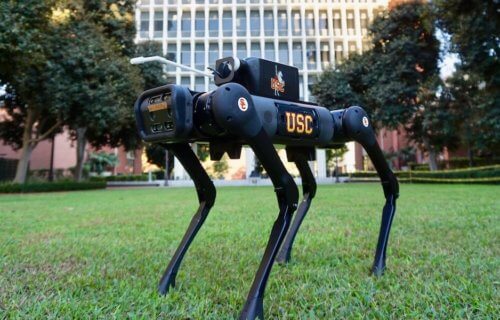LOS ANGELES, Calif. — When schools, shops, and offices all over the world fully reopen, who is going to handle all the daily disinfecting in these buildings? The answer could be a robot no bigger than the average dog. Researchers from the USC Viterbi School of Engineering have created the first four-legged robot designed to clean all the tight spaces it could take humans hours to disinfect.
LASER-D (Legged Agile Smart Efficient Robot for Disinfection) is the first machine to combine locomotive agility and chemical disinfection in the fight against COVID-19. Led by professors SK Gupta and Quan Nguyen, USC researchers adapted an earlier project focusing on UV disinfection and combined those skills with Prof. Nguyen’s mobile machine.
“This is the first time we’ve combined a legged robot with the disinfection task,” says Nguyen, an assistant professor of aerospace and mechanical engineering, in a university release. “This can be challenging, because we need to maintain mobility while positioning for disinfection. LASER-D conserves energy by walking and positioning its body simultaneously. Thus, we can just use the robot orientation to control the spraying of disinfectant, instead of attaching an extra arm to perform this task.”
LASER-D therefore has the ability to go where robots on wheels would have a hard time getting to, like stairs and in between desks. The team of USC Viterbi master’s students successfully tested their invention around the California campus. Although LASER-D can’t work on its own yet, study authors say their goal is to make the robot more autonomous moving forward.
“Like a human, the system should be able to identify what has to be disinfected, whether or not the disinfection took place properly during the first round, and whether or not the robot should move on or perform a second round of disinfection. These are all targets of the future version of LASER-D,” master’s student Abhinav Pandey explains.
LASER-D, the farmer?
Researchers add that their four-legged prototype may even find a future in the agriculture industry once its COVID-disinfecting duties are over.
“A robot like LASER-D could perform very localized agricultural tasks like precision pesticide dispensing or precision irrigation,” Prof. Gupta says.
The Smith International Professor of Mechanical Engineering and Computer Science adds that LASER-D is also perfect for cleaning crowded areas like shopping malls and cluttered offices.
COVID-fighting robot sees two things: clean and not clean
The USC team’s goal was to create a robotic option that can do the repetitive, tedious, and even dangerous jobs of humans which also require precision skill. While robots like this usually need to view thousands of images to build up the proper skills, the study authors gave LASER-D just two things to learn.
“We trained the machine on a pair of images instead,” Pandey says. “One image was of the surface prior to disinfection and the second image was of the surface post-disinfection. This created a higher level of accuracy in terms of LASER-D identifying whether or not an object had been disinfected—and adequately.”
LASER-D’s vision system not only allows the operator to look at what the robot sees, but allows them to adjust LASER-D’s actions during the cleaning process. Focusing on just two things (clean and not clean) also helps the robot deal with various types of surfaces it can encounter in a classroom.
“When lighting conditions aren’t good, human eyes might not be able to detect areas that were not coated by the disinfectant, however, the vision system can,” Prof. Nguyen explains.
“This is the most challenging aspect,” Pandey adds. “Identifying whether an object is a table or a chair has been done before, but identifying if an area has been disinfected is a new problem we had to solve.”
Mapping out the road to disinfection
So how does a four-legged bottle of disinfecting spray know where to go? Researchers say they program “waypoints” into LASER-D, which are particular spots to walk to on a given map. The human operators first get a map of the room they want cleaned. They then pick out specific waypoints which will help guide LASER-D navigate and disinfect anything it senses as not clean. In the future, the USC team hopes to enhance LASER-D so the robot can navigate rooms all by itself.
“Currently the robot has to be very close the human operator, but in the future, people could be all the way across campus, or even in a completely different location,” Gupta says.
“Locomotion of legged robots in rough terrain is a challenging problem in and of itself. The problem for us right now is combining locomotion with disinfection,” Prof. Nguyen concludes.
https://youtu.be/v388sHf8FGE
